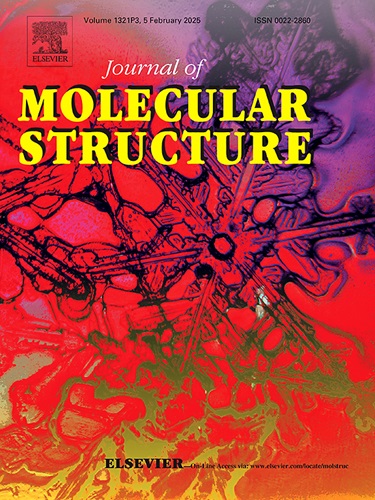p-cresol quantum-classical photodynamics, photostatic UV, IR and Raman spectra
IF 4
2区 化学
Q2 CHEMISTRY, PHYSICAL
引用次数: 0
Abstract
A joint theoretical and experimental study of photoinduced physicochemical and thermodynamic properties of p-cresol was performed using conventional quantum-mechanical approaches and hybrid quantum-classical methodologies combined with the experimental optical absorption and fluorescent spectroscopy. The CCSD, CC2, MP2 and DFT methods as well as the EoM-CCSD, ADC(2)-MP2 and TD-DFT extensions to electron excitations were involved for optimizations and vertical electron transitions in the isolated p-cresol molecule and continuum implicit solvent model. The absorption and fluorescence spectra of the p-cresol in water were measured experimentally to be used as a reference. Static optical spectra were obtained as the statistically averaged electronic states of instantaneous vibrational conformers fluctuating on quantum-classical molecular dynamical trajectories due to combinations of classical forces with quantum gradient and embedding electrostatic potential fitting with point atomic charges. The excited dissipative crossing potential energy surfaces were defined through conical intersection searches and non-adiabatic molecular dynamics simulations using mixed-reference spin-flip with trajectory surface hopping for photodynamic propagation. Conical intersection points were considered for direct transitions from the lowest excited state to the ground state, as well as for two-stage transitions from the second excited state through a lower-lying level to the unexcited electronic structure. The electronic types of excited states at their intersections and key points on photodynamic trajectories were revealed using electron density differences and Dyson’s molecular orbitals based on the extended Koopmans' theorem, whereas canonical molecular orbitals were applied for conventional quantum-mechanical methods. Swift O-H deprotonation through the |π→〉 transition was demonstrated using both conical intersection and photodynamic simulations.
对甲酚量子经典光动力学,光静态紫外,红外和拉曼光谱
采用传统的量子力学方法和量子经典混合方法,结合实验光吸收和荧光光谱,对甲酚的光致物理化学和热力学性质进行了理论和实验研究。利用CCSD、CC2、MP2和DFT方法,以及EoM-CCSD、ADC(2)-MP2和TD-DFT扩展到电子激发,对分离的对甲酚分子和连续隐式溶剂模型进行了优化和垂直电子跃迁。实验测定了对甲酚在水中的吸收光谱和荧光光谱,作为参考。静态光谱是在量子-经典分子动力学轨迹上波动的瞬时振动构象的统计平均电子态,这是由于经典力与量子梯度的组合以及嵌入静电势与点原子电荷的拟合。通过锥形相交搜索和光动力传播的非绝热分子动力学模拟,定义了受激耗散交叉势能面。从最低激发态到基态的直接跃迁,以及从第二激发态通过较低能级到非激发态的两阶段跃迁,都考虑了锥形交点。基于扩展库普曼定理,利用电子密度差和光动力轨迹交点处的激发态电子类型和戴森分子轨道,而常规量子力学方法则采用典型分子轨道。通过锥形交叉和光动力学模拟,证明了|π→σOH* >跃迁过程中O-H的快速去质子化。
本文章由计算机程序翻译,如有差异,请以英文原文为准。
求助全文
约1分钟内获得全文
求助全文
来源期刊

Journal of Molecular Structure
化学-物理化学
CiteScore
7.10
自引率
15.80%
发文量
2384
审稿时长
45 days
期刊介绍:
The Journal of Molecular Structure is dedicated to the publication of full-length articles and review papers, providing important new structural information on all types of chemical species including:
• Stable and unstable molecules in all types of environments (vapour, molecular beam, liquid, solution, liquid crystal, solid state, matrix-isolated, surface-absorbed etc.)
• Chemical intermediates
• Molecules in excited states
• Biological molecules
• Polymers.
The methods used may include any combination of spectroscopic and non-spectroscopic techniques, for example:
• Infrared spectroscopy (mid, far, near)
• Raman spectroscopy and non-linear Raman methods (CARS, etc.)
• Electronic absorption spectroscopy
• Optical rotatory dispersion and circular dichroism
• Fluorescence and phosphorescence techniques
• Electron spectroscopies (PES, XPS), EXAFS, etc.
• Microwave spectroscopy
• Electron diffraction
• NMR and ESR spectroscopies
• Mössbauer spectroscopy
• X-ray crystallography
• Charge Density Analyses
• Computational Studies (supplementing experimental methods)
We encourage publications combining theoretical and experimental approaches. The structural insights gained by the studies should be correlated with the properties, activity and/ or reactivity of the molecule under investigation and the relevance of this molecule and its implications should be discussed.
 求助内容:
求助内容: 应助结果提醒方式:
应助结果提醒方式:


